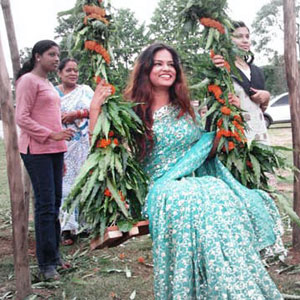
Raja is an agriculture oriented festival, mostly observed in the coastal districts of Orissa for three days. The last day of month “Jestha” is known as “Pahili Raja” and the first day of month “Asadha” is Raja Sankranti (Mithuna Sankranti) from which rainy season starts. It also inaugurates the agricultural year all over Orissa which marks the moistening of summer parched soil with the first shower of monsoon making it ready for productivity. The second day of “Asadha” is known as “Bhuin Dahana”.
During the three days women are given a break from household work and time to play indoor games. Unmarried girls decorate themselves with new fashion or traditional Saree and Alatha in feet. All people abstain from walking barefoot on earth. People play a lot of indoor and outdoor games. Girls play swings tied on tree branches whereas aged ladies play Cards and Ludo. Many villages organise Kabbadi matches among young men.
Special varieties of cake prepared out of recipes like rice-powder, molasses, coconut, camphor, ghee etc goes in the name of Poda-pitha (burnt-cake ). The size of the cake varies according to the number of family members. Cakes are also exchanged among relatives and friends.
According to popular belief as women menstruate, which is a sing of fertility, so also Mother Earth menstruates. So all three days of the festival are considered to be the menstruating period of Mother Earth. During the festival all agricultural operations remain suspended. As in Hindu homes menstruating women remain secluded because of impurity and do not even touch anything and are given full rest, so also the Mother Earth is given full rest for three days for which all agricultural operations are stopped.
Significantly, it is a festival of the unmarried girls, the potential mothers. They all observe the restrictions prescribed for a menstruating woman. The very first day, they rise before dawn, do their hair, anoint their bodies with turmeric paste and oil and then take the purificatory bath in a river or tank.
Peculiarly, bathing for the rest two days is prohibited. They don’t walk bare-foot do not scratch the earth, do not grind, do not tear anything apart, do not cut and do not cook. During all the three consecutive days they are seen in the best of dresses and decorations, eating cakes and rich food at the houses of friends and relatives, spending long cheery hours, moving up and down on improvised swings, rending the village sky with their merry impromptu songs. The Raja gita (a folk song) sung by the people is:
“Banaste dakila Gaja,
Barasake thare aasichhi Raja,
Asichi Raja lo gheni nua sajabaja.”
“Banaste dakila Gaja,
Barasake thare aasichhi Raja,
Asichi Raja lo gheni nua sajabaja.”
“Pana khia Rasika Pati,
Khoji buluthila Rajanka hati,
Dhali deigala sirare,
Raja hoigale rajare.”
Khoji buluthila Rajanka hati,
Dhali deigala sirare,
Raja hoigale rajare.”
Celebration of raja is one of the oldest tradition of Orissa. Slowly, the festival is loosing its importance in young minds. We should try to celebrate this festival so that the young generation will learn importance of the occasion.











.jpg)












0 comments:
Post a Comment